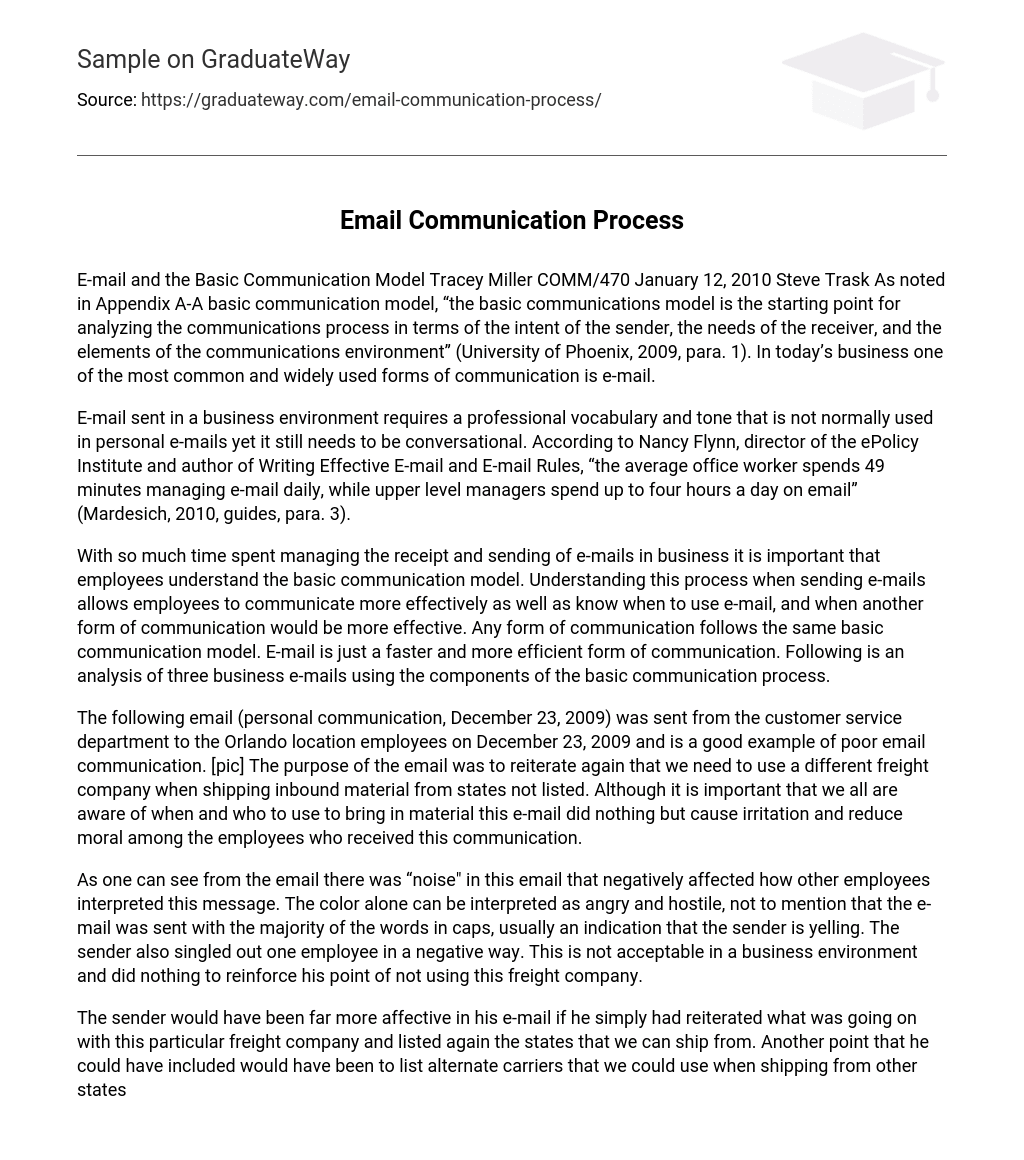The University of Phoenix (2009) states that the basic communications model is a crucial framework for analyzing the communication process, which includes the sender’s intent, receiver’s needs, and the communications environment. In contemporary business settings, email is widely used and preferred as a means of communication.
In a professional setting, emails should maintain a formal vocabulary and tone, though still remaining conversational. Nancy Flynn, director of the ePolicy Institute and author of Writing Effective E-mail and E-mail Rules, explains that office workers spend about 49 minutes per day managing emails, while upper-level managers dedicate up to four hours daily to email correspondence (Mardesich, 2010, guides, para. 3).
It is crucial for employees to grasp the fundamental communication model in order to effectively handle the receipt and transmission of emails in business settings. This understanding facilitates more efficient communication and helps employees determine when email is the appropriate medium or when another form of communication would be more suitable. All forms of communication adhere to the same basic communication model, with email being a swifter and more efficient option. The following analysis examines three business emails, applying the components of the basic communication process.
The email below (personal communication, December 23, 2009) was sent from the customer service department to the Orlando location employees on December 23, 2009. It serves as an example of poor email communication. The email’s intention was to emphasize the need to use a different freight company when shipping inbound material from states not listed. However, instead of effectively informing and reminding employees about this matter, the email only led to irritation and decreased morale among its recipients.
In the email, it is evident that there was disruptive content that had a detrimental impact on how other employees perceived the message. The use of a bold color alone can be seen as expressing anger and hostility, coupled with the majority of words being in capital letters, typically conveying a tone of shouting. Furthermore, the sender specifically targeted one employee in a negative manner. Such behavior is not appropriate within a professional setting and failed to effectively emphasize the point of avoiding the use of this freight company.
The sender could have been more effective in his email by restating the situation with the freight company and reiterating the list of states we can ship from. Additionally, he could have included a list of alternative carriers for shipping from other states. The next email, which was sent on December 23, 2009, was a forwarded message from one of the manufacturers we import from. It was sent to the entire company and copied our logistics director.
The email includes a PDF attachment of materials that this manufacturer is discontinuing. While it may seem like a straightforward email with relevant information for all employees, the listed materials are only distributed from our Atlanta location. Employees in the Savannah and Orlando locations have never distributed these materials and are unfamiliar with them. Considering the high volume of emails employees receive daily, there was no necessity for her to send this email to the entire company.
Sending this useless piece of information to employees who do not need it actually had the opposite effect of increasing the flow of information. This caused a decrease in productivity as some employees wasted time and energy researching a material that we do not even have in our system. The email below, which was sent to me by one of our outside sales representatives, is an example of the aforementioned situation.
While visiting dealers, she discovered the need for comprehensive literature discussing the distinctions among stone, tile, and porcelain. Although she didn’t require the information urgently, she wanted to verify its availability and determine where she could access printed copies upon returning to the office. Utilizing her phone’s email capabilities, she had the flexibility to send me a message while connected to a signal, eliminating the necessity of a phone call.
By enabling me to reply to her through email, it provided the convenience of flexibility in responding at my own convenience. This also resulted in a documented record of our communication for future reference, as well as the ability for her to flag the message for quick access later on. When reviewing my response, I realized that adding the location of this notebook would be helpful. This way, if she returns to the office and I am not present, she can easily find the necessary information.
The method of communication, whether in person or via e-mail, remains the same. However, e-mail is a more efficient and convenient way to communicate. In a workplace environment, effective communication should reduce message delivery time compared to other methods, thereby enhancing productivity by reducing the necessity for face-to-face meetings or phone calls.
Employees can improve their email communication skills and know when it is appropriate to use this medium by understanding the communication process. Additionally, they will be able to identify situations where face-to-face communication would be more suitable.
References
- University of Phoenix. (2009). A basic communication model. Retrieved from University of Phoenix, COMM/470- Communicating in the Virtual Workplace website.
- Mardesich, J. (2010). How to use email to improve customer service. Inctechnology. com. Retrieved from http://www. inc. com/guides/cust_email/20909. html





